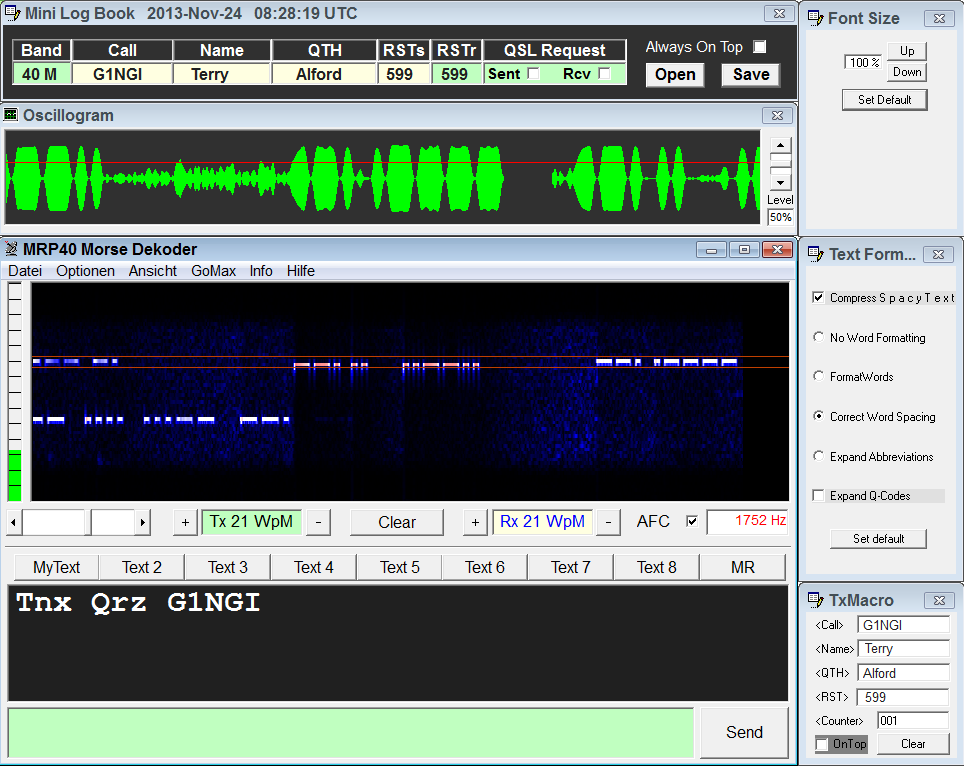

A Histogram of the tone signal levels with a marker for the detection threshold level are displayed next to the waveform graph.
#FREE CW DECODER MANUAL#
The iPad version also includes a switch to enable manual threshold control. On the iPhone or iPod Touch, tap to the left of the waveform graph to switch the manual threshold slider on and off. But you can also manually control the threshold setting. Also, please use the manual settings if automatic decoding does not adjust to the frequency, WPM or background noise threshold level.īy default, the threshold (the signal level above any background noise required to detect a dot or dash) is set automatically by the AGC. So make sure to aim your iPhone so the the tones show up in the spectrum display.
#FREE CW DECODER CODE#
Please note that it is easy to mis-aim an iPhone's microphone so that its noise cancelling microphone will cancel out any Morse Code tones. (QRQ mode also supports higher frequency dot-dash tones.) There is a QRQ High Speed WPM Mode which will work better for code speeds in the range of 30 to 80 WPM.
#FREE CW DECODER PLUS#
You can also manually set the WPM code speed using the plus and minus symbols that appear in the waveform graph, or the slider control on an iPad. One the iPhone, tap the lock button to the right of the waveform graph to lock and unlock automatic WPM detection. The Morse code WPM (words per minute) detection speed is automatically adaptive from about 8 to 40 WPM, and can be locked to the current estimated WPM dot speed (WPM lock icon locked). On the iPhone, tap the lock button to the right of the spectrum graph to toggle the filter off and on. Tap the spectrogram to set the audio filter to the frequency of a selected frequency peak. The filter can also be left off in a wide-band mode (frequency lock icon unlocked). If the audio filter is enabled (frequency lock icon locked), it can be set for frequencies in the range of 400 to 1400 Hz. You can then use the optional narrow-band audio filter to help filter out background noise. The Morse Code Decoder includes a built-in spectrogram to help determine the audio frequency of the Morse Code tones.

Decoding parameters that can be manually adjusted include the audio frequency of an optional narrow-band DSP filter, the WPM dot/dash speed used for detecting characters, the threshold level of background noise, and whether Farnsworth timing is to be used for detecting spaces between individual characters.

It includes both automatic decoding of longer clean signals and manual controls to allow the decoding of more difficult signals in QRM. The HotPaw Morse Code Decoder takes audio input from the microphone or headset input on your iPhone or iPad, decodes Morse Code, and displays the results in text form. If all you are doing is receiving, all you need to do is couple your rig's audio output to the PC's MIC input.Translate Morse Code or CW audio to text. You just drag the index lines with a mouse - and you can see where to move them. Also, CWGet has very easy to use filter frequency and trigger threshold settings. In setting up CWGet, I found it worked best if I disabled all the MIC advanced audio in the PC. Here is one source for a splitter w/ the converter included -įinally, you may have a problem with a ground loop, and an isolation transformer will solve that problem. Also, there are two TRRS standards (pretty much Apple vs everyone else), so you may need a CTIA to OMTP converter. You need a "splitter", even if you don't plan to connect anything to the splitter's earphone jack. This combines Audio In & Out in the same jack. However, if your laptop is reasonably modern, it probably has a TRRS connector for a headset. If your laptop is older, it probably has separate Audio In & Out jacks. Click to expand.If all you are doing is receiving, all you need to do is couple your rig's audio output to the PC's MIC input.


 0 kommentar(er)
0 kommentar(er)
